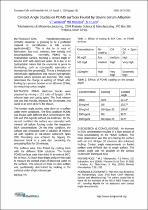JavaScript is disabled for your browser. Some features of this site may not work without it.
- ResearchSpace
- →
- Research Publications/Outputs
- →
- Journal Articles
- →
- View Item
| dc.contributor.author |
Windvoel, VT

|
|
| dc.contributor.author |
Mbanjwa, MB

|
|
| dc.contributor.author |
Land, K

|
|
| dc.date.accessioned | 2010-02-09T12:56:09Z | |
| dc.date.available | 2010-02-09T12:56:09Z | |
| dc.date.issued | 2010 | |
| dc.identifier.citation | Windvoel, VT, Mbanjwa, MB and Land, K. 2010. Contact angle studies on PDMS surfaces fouled by bovine serum albumin. European Cells and Materials, Vol.19(Supplement 1), pp 23 | en |
| dc.identifier.issn | 1473-2262 | |
| dc.identifier.uri | http://www.ecmjournal.org/ | |
| dc.identifier.uri | http://hdl.handle.net/10204/3937 | |
| dc.description | Copyright of this article belongs to the authors. | en |
| dc.description.abstract | Polydimethylsiloxane (PDMS) has a hydrophobic surface, forming a contact angle of around 110º with deionised water. It is due to its hydrophobic nature that the elastomer is prone to bio-fouling, such as non-specific adsorption of biomaterials like proteins. This is a limitation to microfluidic applications that require hydrophobic surfaces where proteins are involved. This study determines the change in wetting of PDMS after fouling by a protein, bovine serum albumin (BSA), by measuring contact angles. | en |
| dc.language.iso | en | en |
| dc.publisher | European Cells & Materials Ltd | en |
| dc.subject | Polydimethylsiloxane | en |
| dc.subject | PDMS | en |
| dc.subject | Microfluidics | en |
| dc.subject | Contact angle | en |
| dc.title | Contact angle studies on PDMS surfaces fouled by bovine serum albumin | en |
| dc.type | Article | en |
| dc.identifier.apacitation | Windvoel, V., Mbanjwa, M., & Land, K. (2010). Contact angle studies on PDMS surfaces fouled by bovine serum albumin. http://hdl.handle.net/10204/3937 | en_ZA |
| dc.identifier.chicagocitation | Windvoel, VT, MB Mbanjwa, and K Land "Contact angle studies on PDMS surfaces fouled by bovine serum albumin." (2010) http://hdl.handle.net/10204/3937 | en_ZA |
| dc.identifier.vancouvercitation | Windvoel V, Mbanjwa M, Land K. Contact angle studies on PDMS surfaces fouled by bovine serum albumin. 2010; http://hdl.handle.net/10204/3937. | en_ZA |
| dc.identifier.ris | TY - Article AU - Windvoel, VT AU - Mbanjwa, MB AU - Land, K AB - Polydimethylsiloxane (PDMS) has a hydrophobic surface, forming a contact angle of around 110º with deionised water. It is due to its hydrophobic nature that the elastomer is prone to bio-fouling, such as non-specific adsorption of biomaterials like proteins. This is a limitation to microfluidic applications that require hydrophobic surfaces where proteins are involved. This study determines the change in wetting of PDMS after fouling by a protein, bovine serum albumin (BSA), by measuring contact angles. DA - 2010 DB - ResearchSpace DP - CSIR KW - Polydimethylsiloxane KW - PDMS KW - Microfluidics KW - Contact angle LK - https://researchspace.csir.co.za PY - 2010 SM - 1473-2262 T1 - Contact angle studies on PDMS surfaces fouled by bovine serum albumin TI - Contact angle studies on PDMS surfaces fouled by bovine serum albumin UR - http://hdl.handle.net/10204/3937 ER - | en_ZA |






